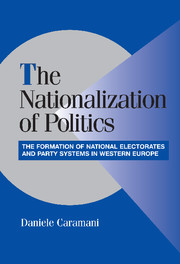 The Nationalization of Politics
The Nationalization of Politics Book contents
- Frontmatter
- Contents
- List of Tables
- List of Figures
- Abbreviations and Symbols
- Preface and Acknowledgments
- INTRODUCTION: HOMOGENEITY AND DIVERSITY IN EUROPE
- Part I Framework
- Part II Evidence
- 3 TIME AND SPACE: EVIDENCE FROM THE HISTORICAL COMPARISON
- 4 TYPES OF TERRITORIAL CONFIGURATIONS: NATIONAL VARIATIONS
- 5 THE COMPARATIVE STUDY OF CLEAVAGES AND PARTY FAMILIES
- Part III Toward an Explanation
- CONCLUSION: FROM TERRITORIAL TO FUNCTIONAL POLITICS
- Appendix 1 Party Codes
- Appendix 2 Territorial Units
- Appendix 3 Computations
- Appendix 4 Country Specificities
- Appendix 5 Sources
- References
- Index
- Cambridge Studies in Comparative Politics
5 - THE COMPARATIVE STUDY OF CLEAVAGES AND PARTY FAMILIES
Published online by Cambridge University Press: 02 December 2009
- Frontmatter
- Contents
- List of Tables
- List of Figures
- Abbreviations and Symbols
- Preface and Acknowledgments
- INTRODUCTION: HOMOGENEITY AND DIVERSITY IN EUROPE
- Part I Framework
- Part II Evidence
- 3 TIME AND SPACE: EVIDENCE FROM THE HISTORICAL COMPARISON
- 4 TYPES OF TERRITORIAL CONFIGURATIONS: NATIONAL VARIATIONS
- 5 THE COMPARATIVE STUDY OF CLEAVAGES AND PARTY FAMILIES
- Part III Toward an Explanation
- CONCLUSION: FROM TERRITORIAL TO FUNCTIONAL POLITICS
- Appendix 1 Party Codes
- Appendix 2 Territorial Units
- Appendix 3 Computations
- Appendix 4 Country Specificities
- Appendix 5 Sources
- References
- Index
- Cambridge Studies in Comparative Politics
Summary
The third main axis of comparison – after time and countries – is that of cleavages and, in particular, the party families that stemmed from them. This chapter compares the overall European levels of homogeneity of support of party families across countries, as well as their evolution over time.
Cleavages and Party Families
For the sake of cross-national and cross-temporal comparison, a series of standard codes have been given to parties. Appendix 1 lists the standard codes and the abbreviations, as well as the parties included in each of the following 10 party families: (1) social democrats, (2) conservatives, (3) liberals (and radicals), (4) communists, (5) Catholics, (6) interconfessional people's parties, (7) Protestants, (8) regionalists, (9) agrarians (and center parties), and (10) greens (ecological parties).
The aggregation of national parties into European families raises a number of problems due to the differences existing between parties of the same family but of different countries. Which national parties have been included in each family? It would be a mistake to include all national parties belonging to a given ideological area (e.g., one could consider including in the social democratic category all Austrian, Belgian, and other national socialist parties). For some families in particular, it is important to distinguish parties and include only parties that are relevant from an ideological, historical, and organizational point of view. The first term defines the political family of parties.
- Type
- Chapter
- Information
- The Nationalization of PoliticsThe Formation of National Electorates and Party Systems in Western Europe, pp. 154 - 192Publisher: Cambridge University PressPrint publication year: 2004


